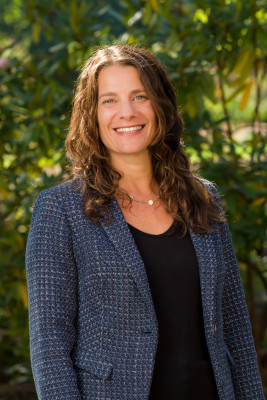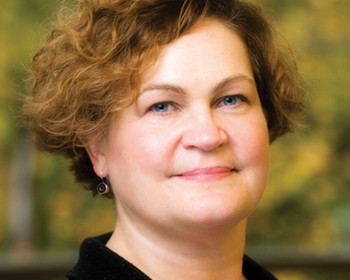Taking a New Look at Oregon’s Death Penalty
A research opportunity with her faculty mentor helped this student find her future.
By Andrew Faught

London native Venetia Mayhew ’17 was shocked when she discovered in 1986 that the majority of U.S. states—today, the number stands at 31—permit capital punishment.
We’re spending millions of dollars on a system that we’re not even using…”Venetia Mayhew ’17
“Obviously, England has a pretty gory history, but when I found out America still had the death penalty, it jarred me,” said Mayhew, who moved to the United States when she was 21. “It conflicted with my perception of America.”
Living in the U.S. for nearly two decades dispelled her shock, but not her sense that matters needed to change. She set out to learn more. Mayhew enrolled at Portland State University, where she double majored in philosophy and political science. Her interest in the death penalty motivated her to write her undergraduate thesis about the modern-day death penalty abolition movement. Then, this single parent of two headed to Lewis & Clark.
A Groundbreaking Study
Although there are 34 inmates on Oregon’s death row, the state hasn’t carried out an execution since 1997. In fact, there have been just two since 1984, both of death-sentenced prisoners who sought or hastened their own executions by waiving their right to appeal their conviction and sentence. (In October 2016, Governor Kate Brown ’85 announced she would continue an existing moratorium on capital punishment.)

Many recent headlines concerning the death penalty focus on the efficacy of drugs used to carry out executions. Aliza Kaplan, professor and director of the Criminal Justice Reform Clinic (CJRC) at Lewis & Clark Law School, seeks to frame the discussion differently. A noted death-penalty scholar, she was preparing to embark on the first-ever cost analysis of capital punishment in Oregon when Mayhew, in her first year as a law student, connected with the professor.
Mayhew joined five other law students to work with Kaplan and Peter Collins, associate professor of criminal justice at Seattle University who wrote a 2015 Washington report on which Kaplan planned to model her study. The Lewis & Clark team conducted a review of 374 aggravated, or first-degree, murder cases from between 2000 and 2013, focusing on the financial ramifications of the sentences. They gleaned data from district attorneys, courts, jails, the Department of Corrections, the Office of Public Defense Services, and the Oregon Attorney General’s Office.
“The students drove the work, from reviewing other studies from around the country to gathering all the data, reviewing hundreds of court records, and interviewing the chief justice of the Oregon Supreme Court, the chief judge of the Court of Appeals, defense lawyers, mitigation specialists, district attorneys, and the chief of Department of Justice’s appellate division,” said Kaplan, recipient of the law school’s 2015 Leo Levenson Award for Excellence in Teaching. “It was a terrific opportunity for them.”
The Findings

Oregon’s Death Penalty: A Cost Analysis was released in November 2016. It found that costs for Oregon cases resulting in a death sentence average just under $1.4 million each. Cases that resulted in non-death-penalty sentences—such as life without parole or life with parole—cost an average of $334,522.
The study also revealed a high rate of post-conviction sentence reversals. In Oregon, it showed, 79 percent of death sentences ultimately are reversed. Collins’ report had concluded that Washington’s rate of reversal was a similarly significant 75 percent.
“There is something in this report for everyone, no matter what their views of the death penalty,” said Kaplan. “It’s important for policymakers and taxpayers to know how much everything costs. It’s about transparency.”
“The takeaway, and what I try to explain to people, is that I haven’t seen any evidence that the death penalty is cheaper than alternatives, such as life in prison,” Collins said. “My mission as a social scientist is to provide people with facts, so we can debate the facts. I hope to spur the conversation that way.”
“The economic costs of the death penalty should be a consideration, especially in a state with budget deficits,” Mayhew said. “We’re spending millions of dollars on a system that we’re not even using, when perhaps the money could be better used elsewhere.”
The economic costs of the death penalty should be a consideration…”Venetia Mayhew ’17
Shaping a Career
“As a faculty member, it’s a joy to have such smart, creative, and passionate students working on these projects with me,” Kaplan said. “I feel like I’m the lucky one. Venetia worked beyond the call of duty on the cost analysis. She had the drive to find out the truth.”
“She’s been very generous in giving me opportunities,” said Mayhew of Kaplan. “This was the biggest project I’ve ever worked on. I learned an enormous amount about how the criminal justice system works in Oregon. It was an amazing and unique experience.”
The cost analysis reaffirmed Mayhew’s commitment to justice reform, particularly as it relates to the death penalty. In August 2017, she began working as the CJRC’s first fellowship lawyer. (Learn more about the Criminal Justice Reform Clinic.) Mayhew and Kaplan are collaborating on a clemency project.
“People often have set moral ideas about the death penalty,” Mayhew said, “but how we choose to use our resources—that, too, is a moral question.”
More Advocate Magazine Stories
email jasbury@lclark.edu
voice 503-768-6605
Judy Asbury, Assistant Dean, Communications and External Relations
Advocate Magazine
Lewis & Clark Law School
10101 S. Terwilliger Boulevard MSC 51
Portland OR 97219

